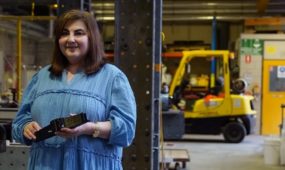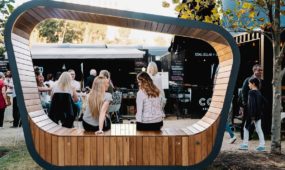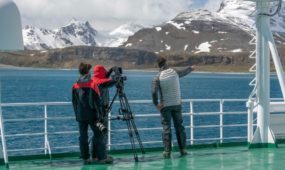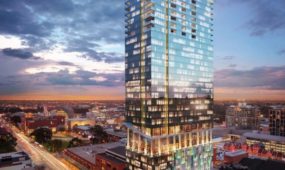A Doctor and Diplomat: Professor David David's Craniofacial Unit
Innovation
Professor David David points from his window, drawing the medical sweep of Adelaide. It starts on the city’s cultural boulevard, North Terrace, moving past the New Royal Adelaide Hospital, the research institute SAHMRI, past Parliament House and the University of Adelaide, across the River Torrens to the Women’s and Children’s Hospital and back to his Australian Craniofacial Unit (ACU) on Melbourne Street in North Adelaide.

Sign up to receive notifications about new stories in this category.
Thank you for subscribing to story notifications.
Professor David David points from his window, drawing the medical sweep of Adelaide. It starts on the city's cultural boulevard, North Terrace, moving past the New Royal Adelaide Hospital, the research institute SAHMRI, past Parliament House and the University of Adelaide, across the River Torrens to the Women's and Children's Hospital and back to his Australian Craniofacial Unit (ACU) on Melbourne Street in North Adelaide.
“It's all here,” he remarks of the precinct that is less than three kilometres square in the gridded, planned city.
The connectedness that he observes in his environment is a crucial pillar to his own work – drawing the lines between fields that have brought the ACU to become the preeminent craniofacial surgery in the world.
“We are able to do this because of South Australia,” he says, “Nowhere else can you do this. It's a Renaissance City State. It's just like the old walled cities, where all that wonderful advance was made in society.”
Professor David David AC is a man of singular dedication, vision and – most importantly – legacy.
The ACU has performed more than 10,000 life-changing surgeries since its inception in 1975. The team has healed patients with clefts, growth disorders, trauma, tumours and more.
Beyond that, they've transferred their skills to surgeons around the world, commissioned, produced and promoted cutting-edge research, and influenced health policy around the world.
Tessier
“When our surgical father, this chap called Tessier started off in the 1960s, some of the very serious craniofacial problems, really difficult ones were in mad houses. People thought they were mad, they were bad, they couldn't be treated,” Prof David explains.
“This man thought they could. His concept was one of teamwork. At the time, all of these surgical disciplines like brain surgery, plastic surgery, EMT surgery – they were all developed in separate silos.”
He identified the fact that seemingly insurmountable problems for one field were routine for another. By combining their expertise, these untreatable cases could become treatable.
An example is a maxillofacial surgeon being unable to reach a problem area because the brain is in the way – and declaring it inoperable. Tessier's solution was to find a brain surgeon, for whom moving the brain out of the way is an everyday task, and suddenly the problem is surmountable.
“He set this up in the late 1960s. Some of us, who are his surgical children – I'm the youngest of them – formed the International Society of Craniofacial Surgery.”
Prof David speaks fondly of Tessier, and of his other surgical siblings. Some of their photos adorn the walls of his office.
“We took Tessier's inspiration and a couple of us, a Canadian called Ian Munro, and another man called Linton Whitaker from Philadelphia, we developed it even further.
“We thought, hang on, if you're going to do this with just two guys, why don't we do the lot? Why don't we get a big team and set them up?”
Having spent time with Tessier in England and France, Prof David returned to South Australia.
Tessier had set out a document specifying that you needed a population of at least 15 million people to generate enough cases for a full time craniofacial unit. It wasn't something you could do as a hobby.
Prof David approached South Australia's Premier at the time, the famously reformist Don Dunstan, about setting up a craniofacial unit.
“Brilliant man that he was, he said okay, we've got all the expertise that we need in South Australia. It's a unique place. You've got wonderful universities, fantastic medical services, brilliant weather. We've got people who want to do this.
“We're a parliamentary democracy, we can do things. No bloody committees and all this nonsense – in one minute he just said right, we're going to do that. He said no one else in Australia is doing it, so we want to do it for Australia.”
But the ACU did not just operated for Australians. When officially formed in 1975, the ACU became a regional centre that serviced all of South East Asia, from Shanghai to Indonesia.
“We still have a big input, a big influx from people in South East Asia. At the very moment I have patients from Dubai, from Indonesia, from Malaysia. Every day we get people coming, wanting our expertise,” says Prof David.
centred
It must be multidisciplinary, able to tackle whatever conditions they're presented with. It must be cradle to grave, with no distinctions based on age. Their work must have protocols and measurable outcomes.The fourth principle is that it must be scientifically based. It must also have a strong focus on education and training. Finally, it must be full-time – no hobbyist surgeons dabbling in the field.
Their team includes craniofacial surgeons, neurosurgeons, micro surgeons, ear, nose and throat surgeons, ophthalmologists, social workers, speech pathologists, paediatric professionals, psychiatrists, anaesthetists, radiologists, cardiologists, dentists, respiratory specialists, and support staff.
Patients are offered that support from the moment they're admitted, and it will often continue for years. Cases range from children born with craniofacial issues to adults who have suffered injuries from car accidents or street violence.
“To take it to the extreme, when a little kid in country New South Wales goes to school and a bully comes along and belts the hell out of them for how they look and the teacher says not to worry about it, we get involved in that.
“We'll ring the headmaster and say, 'hang on, these are patients under our care. It's government policy that you have a teasing policy. What's your teasing policy? Why aren't you implementing it? Can we send a policeman to see you?' We intervene right down to that level,” says Prof David.
That kind of care has its payoffs too – and over his career Professor David has seen many patients who began with severe deformities end up attending university, getting their PhD and making a life for themselves – where previously it had been impossible.
In the past, the development of children born with these conditions was often marred. They were left on the outskirts of society, where people like Paul Tessier and Professor David found them in mad houses.
“They had been put there because nobody wanted them. They weren't mad at all. People didn't recognise they couldn't breathe as babies, so any mental deficiency was due to not getting oxygen to the brain,” he says.
The advances that were made to heal children with craniofacial conditions are now applied across many fields. A baby has to breathe. It has to eat, see and hear.
“Function comes first. But function and form are intimately tied together,” explains Prof David. “It turns out that a blind eye tends not to look as good as a normal one. If you don't have a nose you can't breathe and you don't look too good. If you don't have teeth you look horrible and can't chew. It's all connected.”
Procedures that were developed out of necessity to treat those problems naturally apply to the repair work done on damaged adults with broken noses and eye sockets – it also led to many modern cosmetic surgery procedures, the facelift included.
Towards that offshoot of craniofacial research, the Professor is very critical.
“It's demeaning. People do years and years of study to do liposuction. Their eyes start spinning when they hear about the big incomes and they become trapped. It's all bullshit as far as I'm concerned – they take bits out of it and do it for lots of money, not having to put up with the person being sick.
“These techniques didn't come out of making Nefertiti more beautiful. It came out of World War One. People had their faces blown to bits. It comes out of doing this stuff seriously on people who need it done – damaged people.”
“It's that cliché – you teach them to fish, you don't go and give them fish. We have a very strict philosophy – we totally eschew the concept of missionary work.”
What Professor David and the Craniofacial Unit do overseas could be called humanitarian, though he is fairly cautious of that term as well. Others have been handed the title for less committed action – for work that's doctor-centred rather than the patient-centred care for which the ACU strives.
“That's doctors playing with little black babies, practicing on the natives. Learning techniques that look good so you can come back and do proper stuff on the white people at home who are going to pay you. Hate that. Trophy gathering,” the Professor says, with venom.
Instead, it's all about exchanging technology. The ACU travels throughout the world – mostly in South East Asia, where they began their international work – and they teach local doctors the skills necessary to support a sustainable outfit.
“You have to elevate their skills incrementally, to the level that their society can maintain. Going there and saying 'we're going to separate Siamese Twins,’ that's nonsense. A major craniofacial case in Indonesia takes a whole day,” he says.
The ACU passes on the training to allow them to handle certain cases. Over the years these units become more and more capable – and in the meantime, severe cases can be flown to South Australia to receive the level of care they require – eventually being co-managed with the international units.
Education doesn't stop in far-away countries, though. Many surgeons are trained in Adelaide. The ACU offers a number of non-structured fellowships. It also instituted the world's first craniofacial master's degree three years ago.
Students are given minute-to-minute education and supervision, trained in the concepts that the ACU has laid out a staggering amount of research – hundreds of scientific papers and many books.
“It's measurable. You can give a certificate to people and measure the outcomes with respect to their surgery, based on the principles we've introduced. It's scientific.”
Their list of students is long and distinguished. Out of four designated craniofacial units in the United Kingdom, three of their principals were trained in Adelaide. Graduates and fellows have come from Japan, Singapore, America, Canada and more.
Craniofacial
“I was asked to go to Iran during the nasty days there, because we were the only embassy for the West, really. They'd just got rid of the Shah – we were watched every minute of the day. They had microphones in our rooms. Terrible, awful stuff. We nearly perished,” he recalls.
“We have done a lot of things at the request of the government. We've helped out in Indonesia in request to problems with Australians in Bali, just because we're well thought of out there.”
Though these connections are often made in the direst of times, they're designed to run deep from the very start. Conditions might be awful on in the ACU's initial intervention, but international fortunes can turn around quickly.
“I've been to hospitals with raw sewerage in the surgeon's room. Nowadays, these cities are some of the biggest and smartest in the world – they'd eat us alive.”
Their reach has extended to Oman, Kuwait, Dubai, China and beyond. Prof David smiles at the thought that he still receives a Christmas card every year from a mullah working as a plastic surgeon in Tehran.
Prof David's diplomatic journeys and international training programs come full circle in time, when political stability returns and old friends reunite.
The International Society of Craniofacial Surgery welcomes these surgeons as members – as does the more local Asia-Pacific Craniofacial Association, which Professor David commissioned – and these bonds are solidified.
“If we don't think about our place in the world and we just sit here and think about the 'footy and the pies mate, stuff everybody else around us,' we won't be here in 150 years time. Not unless we formulate relationships with people, intimate relationships through education, science, and common goals – unless we become colleagues.
“Every single time we do that, our safety is ensured. That's a big issue of what we've been doing over the years. We set up the wonderful craniofacial unit in Thailand. We've helped in Hong Kong. The Chinese have been dependent on us and now they're doing wonderful stuff,” he says.
Over the years, he's seen barriers slowly come down; the multidisciplinary care that he and his surgical father, Tessier, long advocated for is slowly starting to become mainstream.
The South Australian Health & Medical Research Institute (SAHMRI) has acknowledged that influence in their top-down, intertwined structure.
Former students are crucial parts of craniofacial units around the world. Early training expeditions around South East Asia have resulted in competent surgeons that continue to improve the conditions in their respective countries.
When asked how long he will continue – the 70 plus year old has run the unit for close to 40 years – Prof David is philosophical.
“As long as I'm fit. There's an argument – based on the idea that the workingman hates working and he needs a rest. Then they say the professional man might lose his touch and be dangerous.
“There comes a moment when you can't. There's no question about that. If I stop now just because somebody wants me to, it would stop whatever contribution I could make. If I just went fishing, all that information, that corporate memory, would be lost,” he says.
He argues that he's not there yet. And when he can't perform surgery anymore, he'll contribute in other ways – because anything else would be shunning the responsibility he has.
“You can change the nature of what you do,” Prof David says. “When I can't give my best, I'll give a little less than my best in an area where it doesn't matter, and then I'll stop.”
It could be tomorrow, but he doesn't think so. Doubtless, the Australian Craniofacial Unit would continue. For every single discipline involved, he and his team has ensured that succession is planned well ahead of time.
As the Professor reflects on his career, he sees a life well lived. It has involved sacrifices, and it's not as glamorous or lucrative as other medical professions, but it's worth it.
“It's the most satisfying, most productive way. The amount of income you have is lovely. It's just enough. Your superannuation will be okay. You'll get there. You can have a nice room, you can have the things of this world. You don't have to be greedy. You don't have to be driving this awful, damn machine.
“A lot of my colleagues have started to see that and they've joined in. They see what a good life you have. You have an international reputation. You're respected at all levels.”
His motivation has always been obvious: partly because the work is important, partly because it is challenging, but mostly because of his patients.
“The thought that you can take people that otherwise would not have a life, who now have a potential life. You can come to us, you're treated properly: now you can go to university. You can have a job. You can have a partner, you can have a sex life. You can have all of that if you're managed properly.
“I get a lot of satisfaction out of that thought.”
The Australian Craniofacial Unit
Donate to Professor David's Cranio-Maxillo Facial Foundation Appeal
Jump to next article



